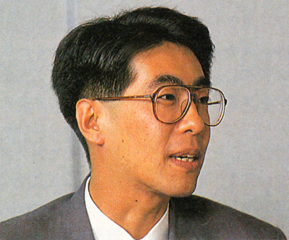Koichi Nagata
From Sega Retro

|
| Koichi Nagata |
|---|
| Place of birth: Hyougo Prefecture, Japan[1] |
| Date of birth: 1961-05-03[1] (age 62) |
| Employment history: Sega Enterprises (1985-04[1] – )
Divisions:
|
| Role(s): Musician, Programmer, Producer, Director |
This teeny-tiny article needs some work. You can help us by expanding it.
Koichi Nagata (永田 浩一) is a former Sega game producer employed during the mid '90s who produced and directed a handful of titles, particularly the home versions of Virtua Racing and various entries in the 32X library. He sometimes worked with Makoto Oshitani.
Early life
Koichi Nagata majored in metal in college and researched Shape-memory alloys. He had no interest in video games, having never touched a computer, but he took a job opportunity at Sega gained through one of his father's acquaintances. He was apprehensive about moving to Tokyo as someone born in Hyougo prefecture, aware that there were many cultural differences.[1]
Career
Although he was most interested in becoming a salesperson for Sega, when Koichi Nagata joined Sega in 1985, he was initially assigned to the sound team, apparently because he mentioned in the job interview that he played trombone in light music club. Half a year later, he was reassigned as a programmer.[1]
His exact works are unknown for nearly a decade, or even whether or not he worked on arcade games or console games, except that he worked on a Game Gear RPG in 1991 with programmer Kenji Shintani[8][9], but in October 1992 he was transferred from Game Gear developer Sega CS2 to Sega CS3,[10] being a game designer at both, and then in April 1993 to Sega AM2, where he was a programmer.[3] A year later he was moved to Sega CS4 as a producer[3], porting several of AM2's hit arcade games to the Mega Drive and 32X.
His next clear career step came in 1996, where he became the manager of Sega CS1.[1] He most likely held this position until 1998, when it was handed over to Makoto Oshitani.[11]
Production history
- Virtua Racing (Mega Drive; 1994) — Director[12] (as Kouichi Nagata)
- J.League Pro Striker 2 (Mega Drive; 1994) — Producer[13]
- Virtua Racing Deluxe (32X; 1994) — Producer[14] (as K.Nagata)
- After Burner Complete (32X; 1995) — Special Thanks[15] (as K.Nagata)
- Metal Head (32X; 1995) — Producer[16]
- Virtua Fighter (32X; 1995) — Producer[17] (as Kouichi Nagata)
- Sega International Victory Goal (Saturn; 1995) — Producer
- Sega Rally Championship (Saturn; 1995) — Special Thanks
- J.League Pro Soccer Club o Tsukurou! (Saturn; 1996) — スペシャルサンクス (as 永田 浩一)
- Dragon Force (Saturn; 1996) — テクニカルディレクター (as 永田 浩一)
- Dragon Force (Saturn; 1996) — Technical Directors (as Kouichi Nagata)
- NiGHTS into Dreams (Saturn; 1996) — Executive Coordination[18] (as Kouichi Nagata)
- Shinseiki Evangelion: 2nd Impression (Saturn; 1997) — ゲームプロデューサー (as 永田 浩一)
- J.League Victory Goal '97 (Saturn; 1997) — Executive Producer
- Pro Yakyuu Greatest Nine 97 (Saturn; 1997) — Producer (as K.Nagata)
- Sega Worldwide Soccer 97 (Windows PC; 1997) — Exective Producer (as NAGATA Koichi)
- Panzer Dragoon Saga (Saturn; 1998) — プロデューサー (as 永田 浩一)
Magazine articles
- Main article: Koichi Nagata/Magazine articles.
References
- ↑ 1.0 1.1 1.2 1.3 1.4 1.5 Sega Saturn Magazine, "1996-09 (1996-06-14)" (JP; 1996-05-24), page 138
- ↑ Harmony, "" (JP; 1992-xx-xx), page 15
- ↑ 3.0 3.1 3.2 3.3 Harmony, "1993 5-6" (JP; 1993-05-20), page 16
- ↑ 4.0 4.1 Harmony, "1994 5-6" (JP; 1994-05-23), page 15
- ↑ Beep! MegaDrive, "January 1995" (JP; 1994-12-08), page 118
- ↑ Saturn Fan, "1996 No. 15" (JP; 1996-07-05), page 94
- ↑ Sega Magazine, "1997-02 (1997-02)" (JP; 1997-01-13), page 19
- ↑ https://jglobal.jst.go.jp/detail?JGLOBAL_ID=200903000040913799
- ↑ [ ]
- ↑ Harmony, "" (JP; 1992-xx-xx), page 15
- ↑ Sega Saturn Magazine, "1998-03 (1998-01-23)" (JP; 1998-01-09), page 22
- ↑ File:Virtua Racing MD credits.pdf
- ↑ File:Pro Striker 2 MD credits.pdf
- ↑ File:Virtua Racing 32X credits.pdf
- ↑ File:After Burner 32X credits.pdf
- ↑ File:Metal Head 32X credits.pdf
- ↑ File:Virtua Fighter 32X credits.pdf
- ↑ File:NiGHTS into Dreams Saturn credits.pdf